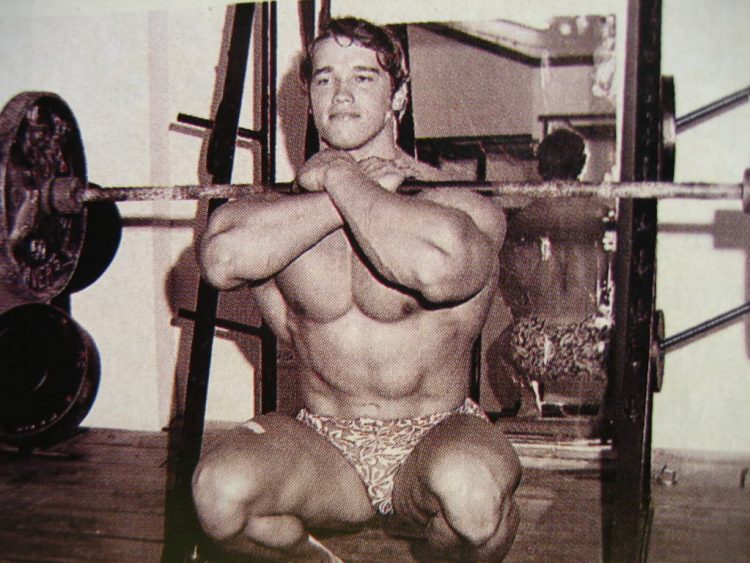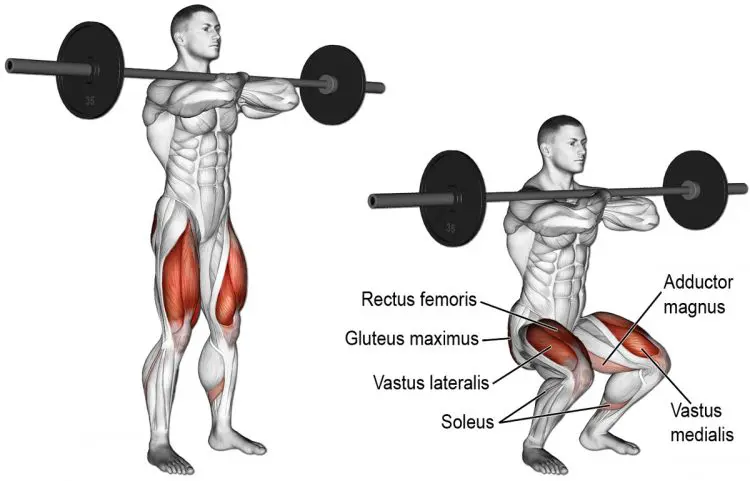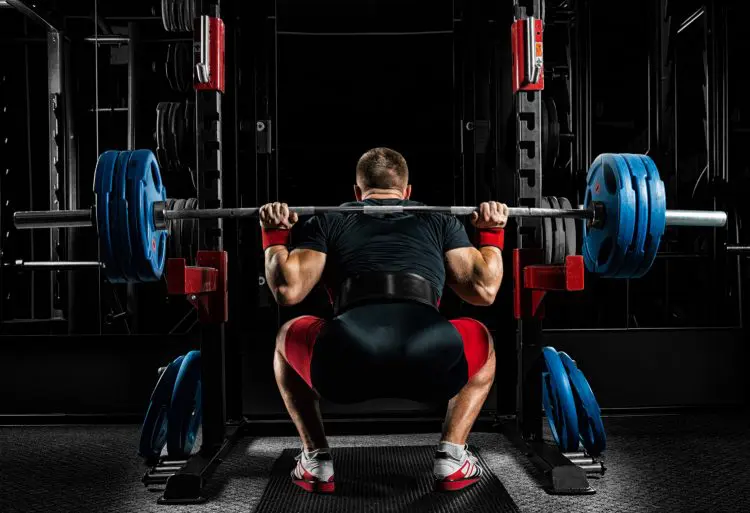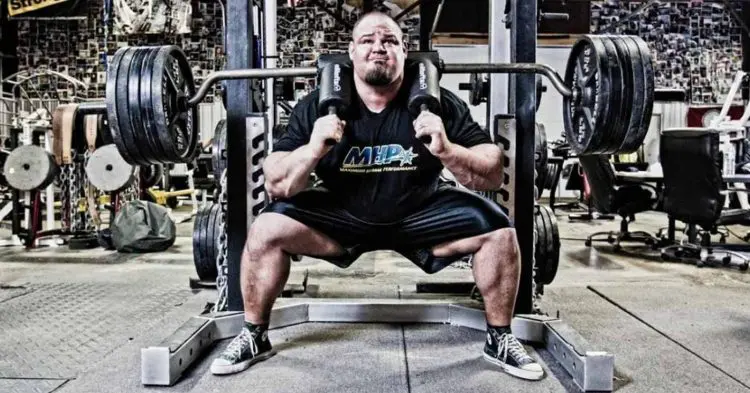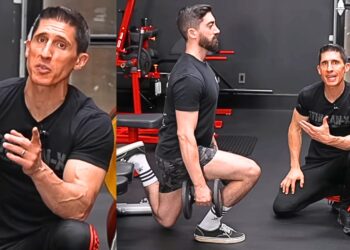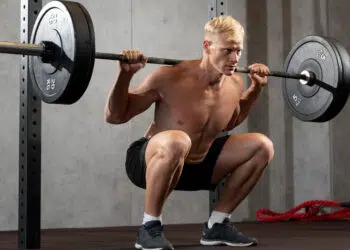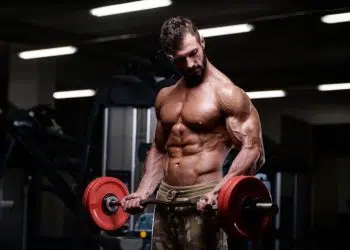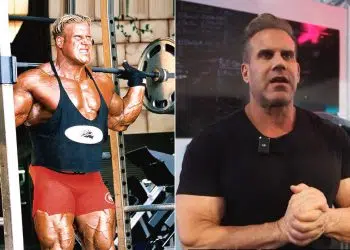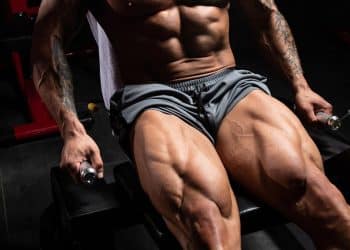Squats are often called the king of exercises. Their ability to build muscle and strength is the stuff of legends. No bodybuilding leg workout is complete without squats, and they’re the first contested lift in powerlifting competitions. Squats often feature in strongman events, too.
Entire workouts have been written around squats, and if you haven’t tried the famous old-school 20 rep squat routine, it’s time you did!
There are two main types of barbell squats – front squats and back squats. They’re both great exercises, but different enough that you may find one better than the other.
Which should you do? We’re here to help you choose!
Front Squat
Front squats are part of Olympic weightlifting. However, they’re also popular with bodybuilders, athletes from all sports, and general exercisers. With front squats, the barbell rests across your anterior (front) deltoids. Your arms can be crossed or bent with your fingers wrapped around the bar and your upper arms parallel to the floor.
Level Up Your Fitness: Join our 💪 strong community in Fitness Volt Newsletter. Get daily inspiration, expert-backed workouts, nutrition tips, the latest in strength sports, and the support you need to reach your goals. Subscribe for free!
Front squats tend to involve a larger movement at the knees and a more upright torso than back squats. However, most exercisers can back squat heavier weights. Front squats also require better upper-body mobility than back squats.
Muscles Worked
Front squats are a compound lower body exercise. That means they involve multiple joints and muscles working together. But, while front squats are most definitely a leg exercise, your upper body is involved too. The main muscles trained during front squats are:
- Quadriceps – front of the thigh
- Hamstrings – back of the thigh
- Gluteus maximus – back of hip
- Abductors and adductors – outer and inner thighs
- Erector spinae – lower back
- Core – midsection/abs
- Trapezius – mid and upper back
- Rhomboids – mid back
- Deltoids – shoulders
How to do front squats
- Put a barbell in your squat rack at about shoulder height, so you don’t have to stand on tiptoes to unrack it.
- Walk forward and put your anterior (front) deltoids against the bar. Grip the bar with your hands just wider than shoulder-width apart. Depending on your flexibility, this may mean you can only get your fingertips to the bar and cannot fully wrap your hands around it. That’s ok; the bar should sit in the creases of your shoulders and remain in place even if you aren’t gripping it with your hands.
- Push your elbows forward and under the bar so your upper arms are parallel to the floor. The bar should rest against your neck, but it should not press heavily on your throat.
- Brace your core and pull your shoulders down and back. Unrack the bar and take 1-2 steps back.
- Set your feet between hip and shoulder-width apart. Most people use a narrower stance for front squats compared to back squats.
- Brace again, inhale, and bend your knees and hips at the same time. Descend as far as you can while keeping your torso upright, your elbows up, and your knees in line with your toes. Do not allow your knees to drop out or fall in. Look straight ahead and not down.
- Without bouncing out of the bottom, drive your feet into the floor and stand back up. Force your elbows upward as you ascend to stop the bar rolling off your shoulders.
- Rerack the bar and rest or, if you are doing multiple reps, reset your core and repeat.
Front Squat – Pros
Can’t decide if front squats are the leg exercise for you? Consider this list of benefits!
Increased range of motion– actual squat depth is determined by several factors, including knee health and flexibility. However, most lifters can usually front squat deeper than they can back squat. A deeper squat increases quadriceps engagement (1), making front squats better for quads hypertrophy. Front squats are also good for improving flexibility and mobility.
A stronger upper back – with the barbell held on the front of your shoulders, your upper back is going to have to work especially hard to keep your torso upright. It’s no coincidence that many Olympic lifters, who do more front squats than back squats, often have such muscular upper backs.
Less stress on your spine – compared to back squats, front squats are done with a much more upright torso. The further forward you lean, the more pressure there is on your spine. Put a weight on your back, and that stress quickly increases.
By allowing a more upright position, front squats put much less strain on your spine than back squats. There is still a compressive force but less shearing force, and it’s the latter that is most likely to cause back injuries.
It’s easier to dump the bar if you fail – back squats should always be done in a power rack. That way, if you get stuck at the bottom of a rep, you won’t get stapled to the floor by a heavy weight. Needless to say, getting stuck under a heavy weight at the bottom of a squat could cause serious injury.
With front squats, you can dump the bar forward and off your shoulders if you can’t complete a rep. While this SHOULD only be done in emergencies, it’s nice to know you have an escape strategy if you fail during a set of front squats.
Less knee joint stress – studies have revealed that front squats are easier on your knee joints than back squats, despite the increased range of motion (2). That’s great news if you suffer from knee pain.
Less shoulder stress – while front squats require good upper body mobility to do them properly, they aren’t as hard on your shoulder joints as back squats can be, especially the low bar variety. Front squats are a good exercise choice for lifters with banged-up shoulders.
Less potential for cheating – when doing back squats, your technique can deteriorate significantly, and you’ll still be able to keep cranking out the reps. Even if you lean forward too far, the bar will remain in place.
With front squats, if you fail to maintain that all-important upright posture or start to lower your elbows, you’ll probably drop the bar. It’s much harder to do front squats with improper technique. Good technique makes any exercise safer AND more effective.
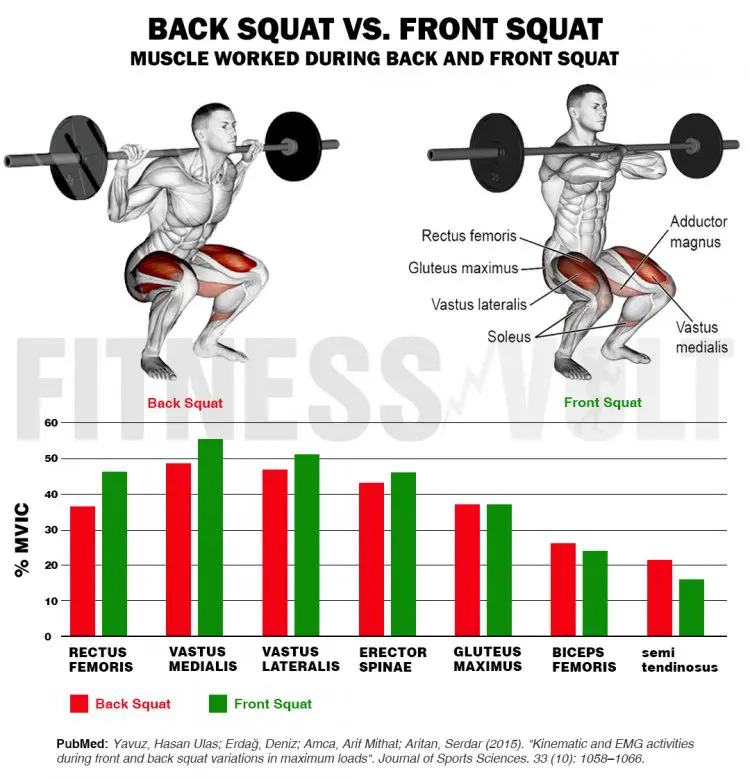
Front Squat – Cons
While there are plenty of benefits to doing front squats, there are drawbacks too…
The front squat rack position can be hard to achieve and maintain – for a lot of people, the front rack position is the hardest part of front squats. It takes good mobility and flexibility to create a solid shelf for the bar to rest on.
If you don’t rack the bar correctly, your arms are much more likely to drop, and so too is the barbell. Tight triceps, lats, and forearms can make achieving and maintaining a proper front rack position difficult, if not impossible. Having big biceps can also make front squats difficult.
Can be uncomfortable with very heavy weights – when you do back squats, the bar rests on the natural padding of your traps. With front squats, depending on the thickness of your deltoids, the barbell may rest on your clavicles or collar bones. It could also press against your throat. Compared to back squats, front squats are usually less comfortable.
Back Squat
Back squats are so-called because the bar rests on your upper back. The bar can be held high across the traps or lower at shoulder level or below – the so-called high bar squat and low-bar squat, respectively. Many bodybuilders favor the high bar squat because it provides more overload for the legs. However, powerlifters often prefer the low bar squat because it allows them to lift heavier weights.
Read more about the difference between high bar and low bar squats here.
Like front squats, back squats are both used to build strength and muscle size. They’re usually done with a straight barbell, but there are other types of bars that can be used for back squats, including safety bars, curved bars, and cambered bars. Each one changes the way the load affects your body, but the actual movement remains mainly unchanged.
Muscles Worked
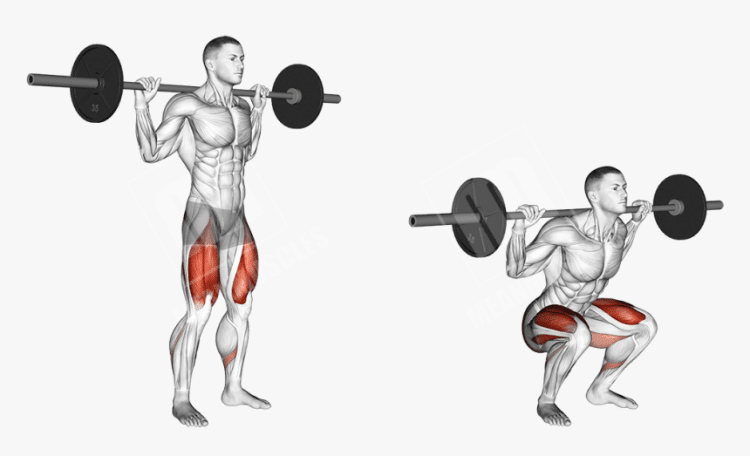
Back squats use the same muscles as front squats, i.e.:
- Hamstrings – back of the thigh
- Gluteus maximus – back of hip
- Quadriceps – front of the thigh
- Abductors and adductors – outer and inner thighs
- Erector spinae – lower back
- Core – midsection/abs
- Trapezius – mid and upper back
- Rhomboids – mid back
- Deltoids – shoulders
How to do back squats
- Put a barbell in your squat rack at about shoulder height, so you don’t have to stand on tiptoes to unrack it.
- Duck under the bar so it rests on your traps or across your shoulders. Grip the bar with your hands just wider than shoulder-width apart. Pull your shoulders down and back and brace your core.
- Unrack the bar and take 1-2 steps back. Set your feet between hip and shoulder-width apart. The taller you are, the wider your stance will probably be. Turn your toes out slightly if you wish.
- Brace again, inhale, push your hips back, and bend your knees. Descend as far as you can without rounding your lower back.
- Ideally, your hips should be level with your knees and your thighs parallel to the floor at the midpoint of each rep. i.e., a parallel squat.
- Keep your knees in line and behind your toes, and do not allow them to drop out or fall in. Look straight ahead and not down.
- Without bouncing out of the bottom, drive your feet into the floor and stand back up.
- Rerack the bar and rest or, if you are doing multiple reps, reset your core and repeat.
Back Squat – Pros
Are back squats right for you? Consider these pros before making your final decision!
Lift more weight – powerlifters do back squats and not front squats. This strongly suggests that the back squat is the best variation for lifting heavy weights. If you care about how many plates you’ve got on the bar, back squats should be your squat of choice.
More balanced leg development – front squats emphasize your quadriceps. Your glutes and hamstrings are working but, with your knees doing more of the work, they’re somewhat less involved.
In contrast, barbell back squats work the front and rear of your legs fairly equally. When you hit parallel or below, your quads and hamstrings get a similarly effective workout. If you want an all-in-one leg exercise, front squats are a good choice.
Level Up Your Fitness: Join our 💪 strong community in Fitness Volt Newsletter. Get daily inspiration, expert-backed workouts, nutrition tips, the latest in strength sports, and the support you need to reach your goals. Subscribe for free!
Easier to learn – while the back squat is far from easy to master, it’s more straightforward to learn than front squats. Many beginners (and plenty of more experienced lifters) find holding the bar for front squats very challenging. After bodyweight, goblet, and Zercher squats, back squats are arguably the next most accessible squat variation.
A standard measure of strength – the back squat is often used to assess lower-body strength, with reaching parallel being the main requirement. This ensures all squat reps use the same range of motion, making it easier to compare performances. Front squats are not usually used for this purpose.
Back Squat – Cons
There are plenty of benefits to doing back squats, but there are drawbacks too…
Increased lower back stress – back squats often involve a pronounced forward lean. While leaning forward helps keep the weight over your feet and increase glute and hamstring engagement, it also puts more stress on the lumbar spine, intervertebral discs, and ligaments.
This issue is made worse if the lifter pushes their hips too far to the rear. The hips should move first during back squats, but only just before the knees bend. Sitting back too far usually leads to more forward lean and more back stress.
Squatting with a weight on your back also increases the risk of rounding the lumbar vertebrae, which can cause serious back injury. Lifters with existing back issues may find front squats more comfortable than back squats.
Hard to escape from if you are unable to complete a rep – heavy back squats should be done in a power rack with the safety bars set to catch the bar at the bottom of your rep. Getting trapped under a heavy barbell can cause horrific injuries. If you fail during front squats, you can just dump the weight on the floor in front of you and won’t get “stapled.”
Can cause shoulder pain – if you’ve got tight pecs, stiff shoulders, or have shoulder joint problems, reaching back to hold the barbell during back squats can prove uncomfortable, if not impossible. A lot of lifters turn to safety bar squats to get around shoulder pain.
Front Squat vs. Back Squat
So, now that you know a little more about front squats and back squats, let’s judge these exercises by a few different criteria:
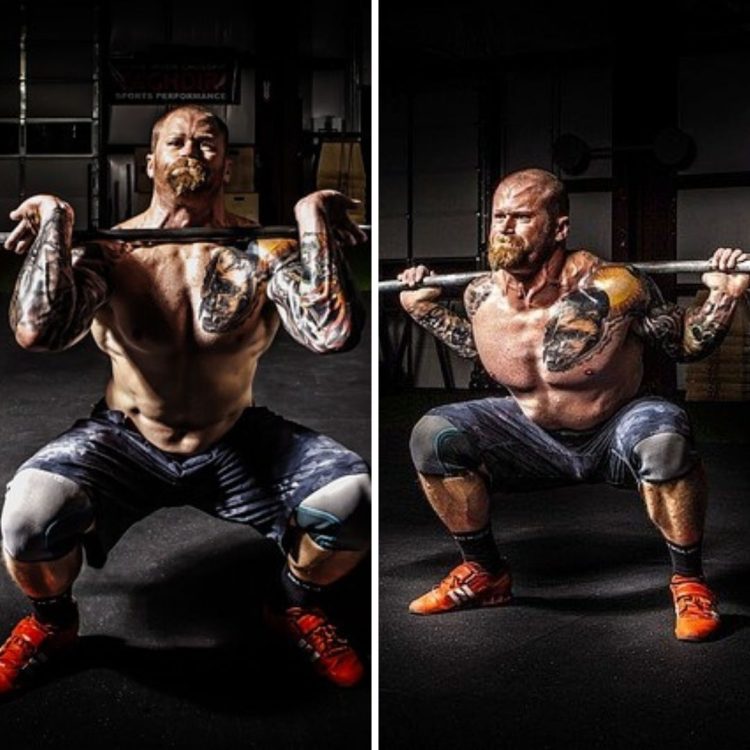
Strength
Both of these squat variations can help build strength. Olympic weightlifters use front squats more than back squats because they’re an integral part of the clean and jerk. Powerlifters do back squats because that’s the lift used in competition.
Ultimately, you should choose the variation you want to get better at. Increases in strength are specific to the exercises you do.
Hypertrophy
If you want bigger quadriceps, front squats are probably your best option. Front squats are more knee-dominant, and while your glutes and hamstrings ARE involved, they take a back seat to your quads.
But, if you want more generalized leg growth and want to work your hamstrings and glutes as much as your quads, back squats are the exercise for you.
Safety
Front squats are potentially safer than back squats. With front squats, your torso is more upright which takes stress off your spine. Also, if you cannot complete a rep, in an emergency, you can just dump the bar on the floor in front of you.
Back squats involve more of a forward lean, increasing shearing force on your spine and increasing the risk of rounding your lower back. Also, with the weight on behind your shoulders, it’s much harder to escape from a failed rep, and you should really only do heavy squats in a power rack.
Of course, if you try and lift too much weight or your technique is not what it should be, both types of squat can cause serious injury.
Ease of Learning
Both types of squat can be tricky to learn. That said, back squats are generally easier because the bar rests naturally on the shelf of your upper traps. In contrast, front squats involve a more awkward and less natural rack position that beginners may find hard to achieve or maintain.
Equipment
In theory, you don’t even need a squat rack to do front squats. You can just power clean the bar up to your shoulders, do your reps, and then put the bar back on the floor. Unless you are using very light weights, a similar maneuver is impossible for back squats. Heavy back squats are best done in a power rack so that if you are unable to complete a rep, you won’t get pinned under the bar.
So, if you don’t have a squat rack, front squats are your best choice.
Variations
One of the best ways to avoid training ruts is to change your workout from time to time and use variations of your main exercises. In many cases, simply altering the width of your stance or the angle of your bench is all that’s needed to avoid progress plateaus.
While switching from front squats to back squats or vice versa is an excellent way to add some variation to your workout, both exercises can be done in several different ways to ensure that you keep making progress, e.g.:
- Squats with chains or bands – to increase load as you approach lockout
- Paused squats – pause at the bottom of each rep for 2-5 seconds
- Speed squats – use 50% of your 1RM and lift the bar as fast as you can
- Box squats – briefly touch a box with your butt at the bottom of each rep
- Anderson squats – start each rep with the bar resting on low pins in a power rack
You can also use specialist bars for back squats, but not all gyms have things like safety squat bars and cambered bars.
Read also
Wrapping Up
Squats rock! They’re a demanding exercise, but they’re all but essential if you want a stronger, more muscular lower body. While there are lifters who have developed impressive lower bodies without squats, they’re in the minority. Squats are probably responsible for building more lower body muscle mass than any other exercise.
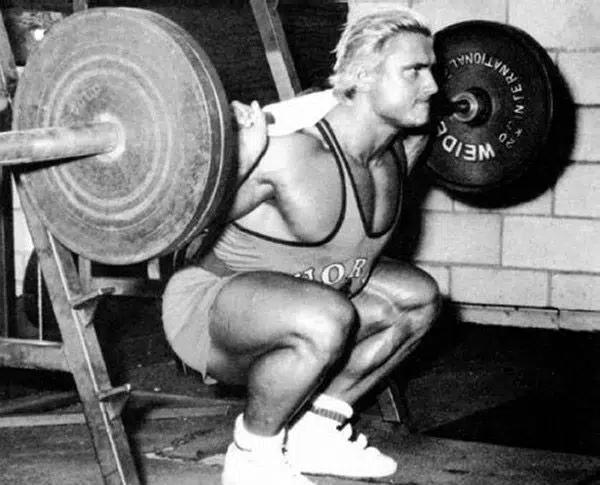
So, between front squats and back squats, which one should you do?
If you want to emphasize your quadriceps, want to avoid overloading your back, and have good upper body mobility, front squats could be your best option. They’re a little harder to learn and master than back squats, but they’re potentially safer.
But, if you want to lift heavy weights, develop all your major leg muscles more equally, and have access to a power rack, back squats are the way to go. They’re also the squat of choice for powerlifters.
Or, instead of choosing, you could do both. Build your leg workouts around front squats for 6-8 weeks, and then switch to back squats for your next training cycle. Alternatively, if you squat twice a week, do front squats one day and back squats later in the week.
Ultimately, you should choose the exercise that matches your training goals, suits you best, and that you can do safely. If there is no clear winner, do them both and enjoy all the benefits front and back squats offer.
References:
1 – PubMed: Kinematic and EMG Activities During Front and Back Squat Variations in Maximum Loads https://pubmed.ncbi.nlm.nih.gov/25630691/
2 – PubMed: A Biomechanical Comparison of Back and Front Squats in Healthy Trained Individuals https://pubmed.ncbi.nlm.nih.gov/19002072/
Interested in measuring your progress? Check out our strength standards for Zercher Squat, Box Squat, Goblet Squat, and more.

